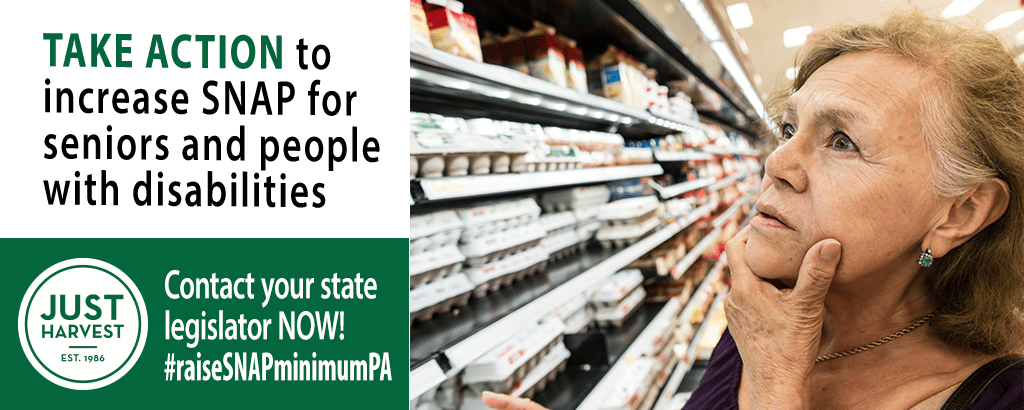 The Supplemental Nutrition Assistance Program (SNAP or “Food Stamps”) is our nation’s first line of defense against hunger. It’s important that SNAP benefits are able to meet people’s needs.
The Supplemental Nutrition Assistance Program (SNAP or “Food Stamps”) is our nation’s first line of defense against hunger. It’s important that SNAP benefits are able to meet people’s needs.
SNAP gives older adults and individuals with disabilities who have low incomes a better chance to stave off hunger. It also improves mental health, frees up income for expenses like housing and medications, and is associated with lower health care costs. However, particularly as we face record inflation, the minimum SNAP benefit of $23 per month is simply too low to help those on a limited budget afford adequate nutrition. To limit the depth and duration of hardship, and to help close the SNAP participation gap among older adults, Pennsylvania should increase the minimum SNAP benefit for seniors and those with disabilities to $35/month.
While the federal government funds SNAP, Governor Shapiro has proposed utilizing $16 million in state dollars to increase the minimum SNAP benefit for households with elderly or disabled members, bringing minimum benefit of $23 per month up to $35 per month. Our PA state legislators must include this proposal in the state budget due June 30, which they are preparing right now.
Take Action to Boost SNAP in PA
Tell your state senator and representative, “Seniors and people with disabilities need help affording food!
Background:
The Supplemental Nutrition Assistance Program (SNAP) is the largest federal hunger safety net program. SNAP is especially important in helping low-income older adults and those with disabilities achieve food security. However, the minimum SNAP benefit of $23 per month is simply too low to help those on a limited budget afford adequate nutrition. The low benefit amount also contributes to low SNAP participation among those who may be hesitant to reach out for help and reluctant to tackle the paperwork required to enroll in the program.
Governor Shapiro’s budget includes a proposed $16 million to increase the minimum SNAP benefit for households with elderly or disabled members from $23 to $35 per month. Investing state dollars to increase the minimum SNAP benefit for these vulnerable populations is a good policy for many reasons:
1) Pennsylvania seniors and those with disabilities living on fixed
incomes simply cannot make ends meet.
SNAP benefits are based on a household’s income, size, and allowable expenses. Economically insecure seniors and those with disabilities — those with income at or below 200% of the federal poverty level ($27,180/year for a single person in 2022) – are eligible for SNAP. But they may qualify for only the $23 minimum benefit, which is not sufficient to cover rising food costs.
Inflation has soared over the past year at its fastest pace in more than 40 years, with costs for food, gasoline, housing, and other necessities squeezing older Pennsylvanians and those with disabilities. Pennsylvania saw the highest grocery inflation rate of any state in 2023, at an 8.2% increase year-over-year.
2) Providing a more adequate benefit can increase SNAP participation and draw down additional federal dollars to support food security
Older adults’ participation in SNAP is staggeringly low. According to USDA, only 45% of Pennsylvania seniors who qualify for SNAP are receiving benefits. Furthermore, there is a pervasive myth that older adults who qualify for SNAP only receive the minimum benefit, but this is largely untrue.
- Nationally, 80% of elderly SNAP participants receive more than the minimum. Increasing the minimum benefit can incentivize greater SNAP participation – including connecting many seniors to the program who are likely to qualify for a benefit amount that is higher than the monthly minimum and paid for with federal dollars.
- The average monthly benefit for a senior living alone in FY19 (the most recent year that data are available) was $104/month.
- Increasing SNAP participation among Pennsylvania seniors will draw down additional federal dollars to support their nutritional needs without the state having to provide a supplement to raise their minimum benefit amount. For these individuals, the $1,248 in average annual SNAP benefits can mean the difference between having food, paying for other necessities, or going without.
3) Access to SNAP is associated with reduced health care costs.
Many older adults are forced to make trade-offs that are potentially dangerous to their health, such as skipping meals and cutting pills in half. They often face choices of whether to “eat, treat, or heat.” Studies have shown that older adults who are food insecure have diets that are less nutritious, worse health outcomes, and higher risk of depression than those with enough food. Access to SNAP benefits that help pay for food can reduce food insecurity, increase medication adherence, and contribute to health care savings. For instance, studies of low-income Maryland seniors found:
- Compared to non-participants, in the year after receiving SNAP, SNAP participants are 23% less likely to enter a nursing home and 14% less likely to be hospitalized. They also had significantly reduced Medicare and Medicaid costs.
- In all, the researchers estimated that, on average, SNAP participation results in approximately $2,120 per year in medical cost savings among income-eligible seniors.
4) SNAP is good for the local economy.
SNAP benefits are spent at community grocery stores and markets, thereby infusing money into the local economy. An analysis of the fiscal stimulus measures from USDA’s Economic Research Service found that additional SNAP benefits created the best return on investment. It is estimated that every $1 in additional SNAP benefits generates $1.79 in local economic activity.




Snap benefits need to increase. I’m disabled and low income and having a hard time surviving on what little I get. It doesn’t cover healthy food for my wife and I.